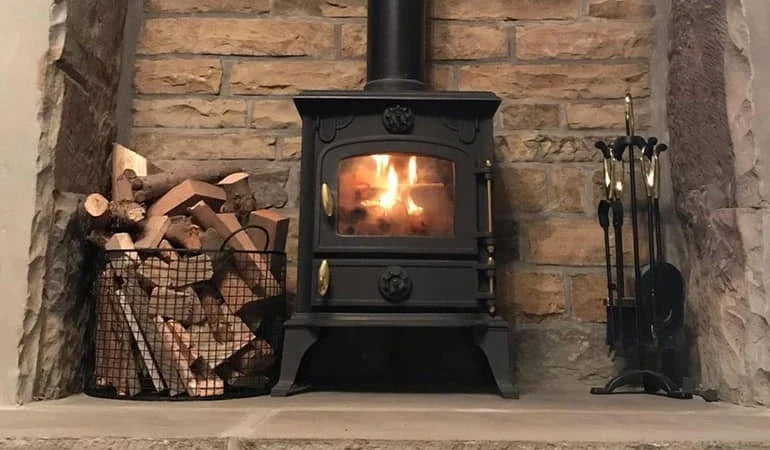0121 271 0221

How to Keep Wood Stove Glass From Getting Black
Being able to see the flames dancing around the firebox is one of the many joys of being a wood-burning stove owner, so the last thing you want is a layer of soot or dirt blocking that view. That’s why it’s essential to know how to keep wood stove glass from getting black.
The first thing to say is that a little bit of soot or cloudiness is normal. Given the environment in which the glass operates, it is inevitable that some of the by-products of burning wood or smokeless fuels will make their mark. You can remove this cloudiness by following these tips on cleaning wood-burning stove glass.
Secondly, we have it much better than our ancestors. Nearly all modern wood-burning stoves come with an in-built airwash system. This uses the stove’s top vent to create a layer of air that washes over the glass and prevents grime from settling.
Given the presence of the airwash system – and bearing in mind what we’ve established about a bit of blackening over time being normal – if your stove glass is regularly going back after use then you might need to chance something about the way you’re operating the stove.
Stop Your Stove Glass Turning Black - in 7 simple steps
How To Avoid Black Glass on a Wood Stove
Let’s look at some of the main reasons your woodburner glass may have turned black, and how to avoid this:
1. Use Seasoned or Kiln-Dried Wood
The main cause of blackening of stove glass is often the burning of unseasoned wood. All logs should be seasoned – that is cut, chopped and left to air – for at least 12 months to allow the moisture level to drop to around 20% or less. Alternatively, they can be dried at high temperatures in a kiln to reduce moisture content.
Using unseasoned wood means energy is used on evaporation rather than burning. This causes an incomplete burn and results in excessive smoke being produced. This settles in the form of soot, tar and creosote inside the flue system and, you guessed it, on the glass.
Seasoned and kiln-dried wood burns more efficiently and produces less smoke, which means less soot, tar and creosote are likely to deposit on the glass.
2. Use Air wash System
Utilize your stove's air wash system correctly. As mentioned above, most wood-burning stoves now come with an air wash to discourage soot from settling on the glass by creating a layer of air over the glass. If your stove is not functioning like that at the moment, you might be using air wash incorrectly.
You should try to avoid closing the air wash vent completely when the stove is in use or the glass will blacken. Learn how to use an airwash on your stove.
3. Consider Fuel Placement
If the glass is blackening in just one or two areas rather than across its entire surface, it might be that you are overloading the stove or loading fuel too close to the glass, causing the fuel to burn against the glass.
If this is the case, be sure to place the fuel further away from the front of the stove.
4. Choose the Right Fuel
Avoid using regular household coal (bituminous coal) in multi-fuel stoves; instead, use recommended smokeless fuels. Smokeless fuels burn cleaner than bituminous coal, thus reducing the amount of soot, creosote and tar produced.
5. Maintain Optimum Burning Temperature
Ensure that your stove operates at the optimum temperature (for instance, don’t try to light a small fire in a big stove as it might not reach a hot enough temperature). A correctly heated stove allows the air wash system to function effectively, preventing soot from settling on the glass.
6. Ensure Good Chimney Draw
If you’ve followed our instructions, double-checked your stove manual for correct usage of the air wash system and ruled out other causes, the problem might be the result of poor draw. In other words, the movement of air from your room, into the stove and up the chimney is not powerful enough.
The poor draw can lead to smoke lingering in the firebox, because it is not being ‘pulled’ up the flue, or prevent the air wash from functioning correctly. Possible solutions are increasing the amount of ventilation in the room or fitting an anti-downdraught chimney cowl.
7. Clean Regularly
Even with all these precautions, before lighting your stove, it's important to maintain it, and regularly clean the glass with a stove glass cleaner. Regular cleaning maintains the clarity of the glass and allows you to enjoy the view of the flames. If your stove glass has already turned black or you still get some discolouration after trying the things we discussed above, you can use stove glass cleaner to remove dirt and restore the view of your flames.
By following these simple steps, you can significantly reduce the chances of your wood stove glass turning black, ensuring a clear view of your fire and a more efficient burning process.
About Gr8Fires
We have been selling heating appliances for more than thirty years, and online at Gr8Fires.co.uk since 2009. Our extensive experience helps you find the right wood-burning stove for your home. We take pride in offering high-quality woodburners and multi-fuel stoves at competitive prices to households throughout the UK.
